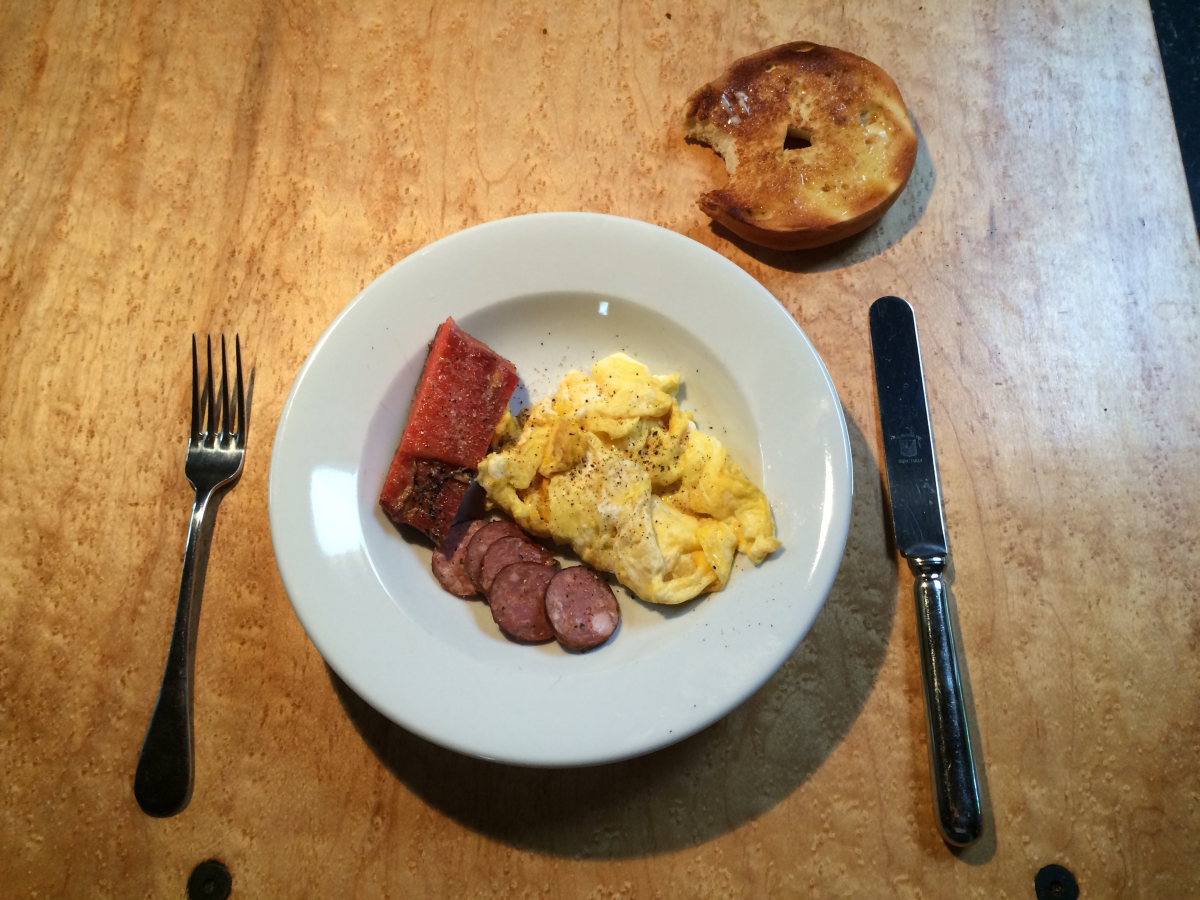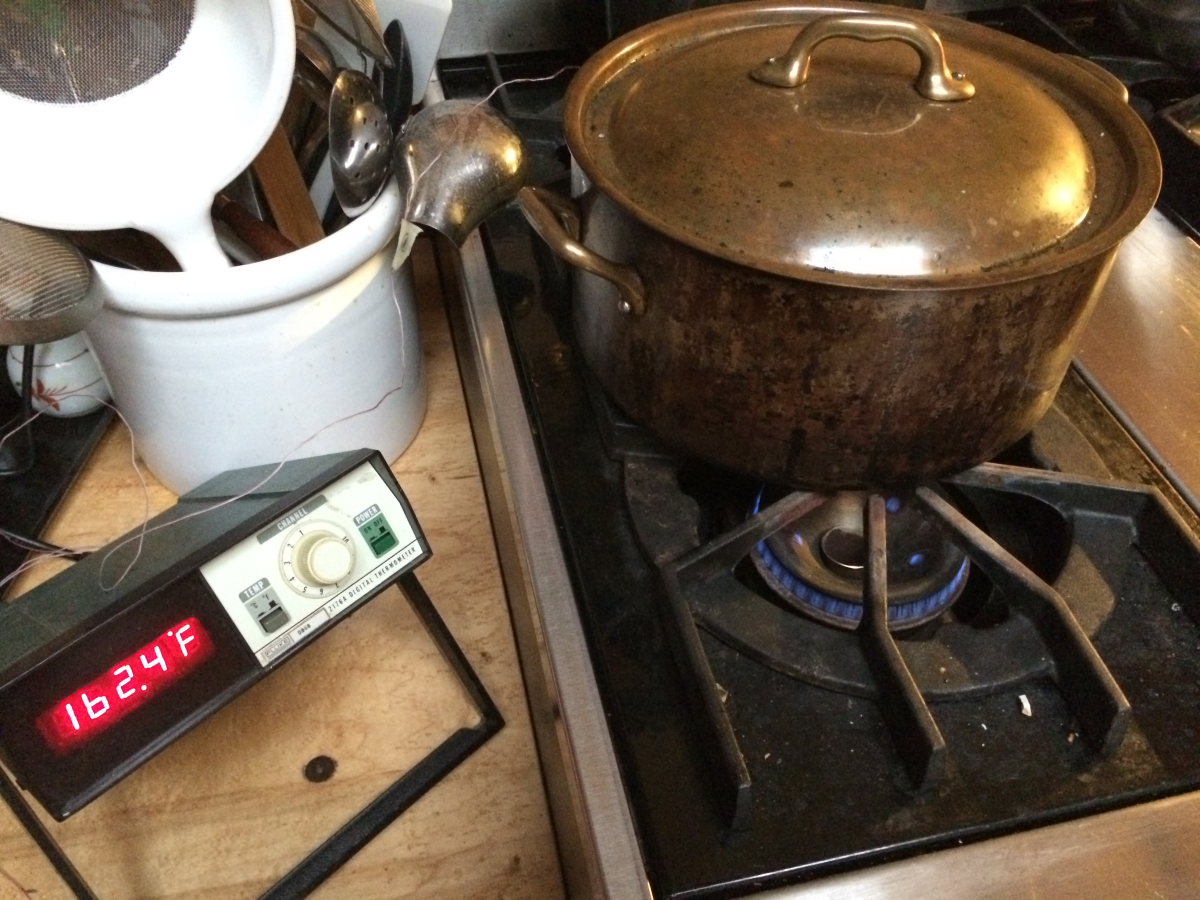There is no processed food in this household. Only meals made from scratch - real food, as opposed to food-like matters. This is my second post on my sous-vide experiments. I bought a chicken and I thought I would do more experiment with sous-vide cooking. My first trial and error of the chicken is cooking one leg/thigh with bone in. I didn't bother to do much research, just figure that 4 hours at 140 F should do it.
Setting up my poor man's sous-vide is now so easy. I noted from my first attempt with a piece of steak the amount of offset (of the Dutch oven with respect to the burner hob) to use. I have been pleasantly surprised with my burner and the copper Dutch oven how steady the temperature is maintained. Once the water temperature reaches equilibrium the temperature stays rock solid within +/- 1 F.
It is worth pointing out that once the temperature stabilized, the heat energy going into the vessel from the bottom equals the heat energy losing in all directions into the air surrounding it. Being in winter the maintenance of the temperature is very easy because of the thermostatically regulated indoor ambient temperature of the kitchen. I have in-floor hydronic heat system (also called radiant heating) so the temperature is very even through out the day. I would expect the amount offset would vary in the summer time with windows open.
The chicken leg and thigh tasted very good, but the meat falls off the bone wasn't achieved with this time-temperature integration of 4 hours at 140 F. It has a lot to do with the chicken. A smaller Asian chicken that are bred for low temperature cooking would be more suitable.
the color of the chicken leg is quite dull; i placed it under the salamander to bring it to life
I divided the remaining chicken into three batches. One with leg/thigh plus two wings to be cooked in Western flavor. One with the half breast which I would cook in Western flavor, and the other half breast which I would cook in Chinese flavor. I vacuum bagged all three at the same time to save time but planned to cook them in batches separately.
since took the trouble to set up the vacuum bagging machine, i prepared three bags
I realize a benefit of vacuum bag process of sous-vide is that you can use it to save a batch of food that you cannot consume fast enough before they spoil. Just cooked them and leave them in the bags refrigerated. The sous-vide cooking essentially pasteurize the food, and being in the vacuum bag no bacteria can get in (if they do the process is significantly slowed).
this bag with just salt, pepper, and a bay leaf - it is raw at this point
here you can see how I offset the Dutch oven from the burner hob to control the temperature; i use a laboratory thermocouple thermometer; this offset gives about 140 F (the lid is removed to show the bags inside for the photo)
I use a laboratory thermocouple thermometer to monitor the temperature because it is my only reliable instrument. My recently bought kitchen thermometer was defective so it went back to Amazon. I ordered the real thing instead - the Thermapen from Thermoworks.
retrieving the cooked thigh and wings
i raised the temperature to 162 F for the next batch of chicken and cooked for about 5 hours; this is the 160 F offset
with higher temperature the result is much better; the chicken is cooked though and much more tender
i also prepared the half-breasts; one in Western and one in Chinese flavors
the Chinese flavor has shiitake mushroom and dried sea scallops
Chinese style chicken served with rice noodles in the chicken broth
I also made another batch of steak using a piece of NY strip steak. This time I want to cook it at 160 F to get more tender meat so the result will be beyond well done.
here is a 1/2 piece of NY strip steak cooked at 160 F for 4 hours
here is the other 1/2 piece of NY strip steak reheating the next day - i added a few slices of shiitake mushroom as garnish
carrots and napa cabbage to accompany the steak
further reduce the steak juice to concentrate it - i threw in a small measure of crumbled blue cheese to add complexity and a lot of umami to the concentrate
the steak is tender and moist - it tastes much like a good pot roast
So far, with the simple set up I see no reason to buy a dedicated sous-vide machine. I am happy with my recent investment of the vacuum bag machine. It proves to be a worthwhile purchase.
The idea of offsetting the pot from the gas burner hob came to me long ago when I tried to keep a pot of stew I was cooking from rolling boil. That was long time ago when I tried to get rid of a crock pot because it was a cheap one that you cannot remove the pot for washing. I didn't want a single purpose cookware that I seldom use taking up precious space. It would be many years later that I leant that French has been doing this a long time. The French cast iron plate cooking hob on cooking range has a circular plate and concentric ring around it. There is no adjustment to the heat intensity of the burner underneath. You do so by offsetting the cooking vessel with respect to the circles. Matched with true copper cookware this method gives excellent and fast control of the heat in the hands of the chef.
So is vacuum bag sous-vide all it crack up to be? To me it is a convenient way of food preparation. Having conducted these experiments, I realized I have been doing low temperature cooking in recent years before these experiments. For instance, I have been braising beef flanks in Chinese styles in sub-boiling temperature using ordinary cooking vessels.
this is how Cantonese like their beef flanks cuts - it is untrimmed
here you can see I used the same burner hob as well as the same Dutch oven
While the temperature I used is a bit higher the result is very comparable in achieving the similar ends. To me vacuum bag sous-vide is just a fancier and more specialized method of slow cooking. It can be very convenient. However, for me I can do this without buying another specialty equipment. It is worth pointing out that my setup is an open loop control system, while the sous-vide machines are closed loop control systems. As long as I know the characteristics and the limitations what I have is good enough for my needs.
I would never be wasteful on the plastic bags as I have seen very often on cooking shows in which a tiny bit of food are placed and cooked in separate bags. I see no reason to rush out and buy a sous-vide machine.
























